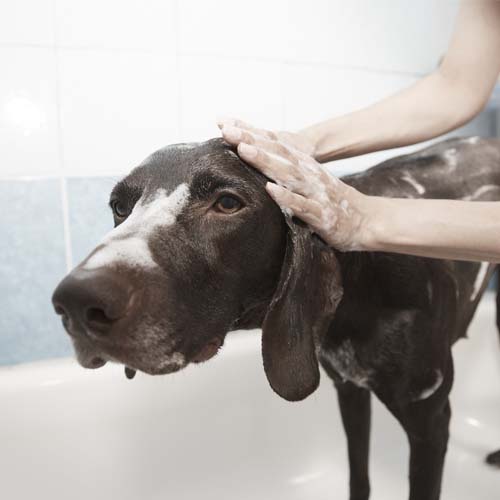What are fleas?
All dog owners are familiar with the problems caused by annoying fleas.
Fleas are tiny, wingless parasitic insects that feed on the blood of dogs. They are brownish red in color, have hard bodies that with hairs and spines, that make it easy for them to move through your dog’s hair. Fleas go through four life cycle stages:
- Egg
- Larva
- Pupa
- Adult
A single female flea can lay up to 2,000 eggs which, if untreated, can spread rapidly in your dog’s fur causing intense itching, hair loss or skin infections. They can also be carriers of different types of diseases that may affect dogs and humans which is why it’s important to treat fleas as soon as they are notice, and more importantly, prevent outbreaks before they have a chance to start.
Fleas and flea larvae thrive in warmer weather and will live outside until the ground freezes in cooler climates. However, even after the weather turns cold, they can live on in your home well past this time.
What to do if you think your dog has fleas?
If you suspect that your dog has fleas, you can purchase a flea comb to check for evidence of a fleas or you can take them to your veterinarian.
A flea comb is a specialized comb with tightly spaced teeth that are designed to detect and remove fleas, flea eggs, and flea dirt from your dog’s fur. Flea dirt is a mix of excrement and dried blood. It looks like small black pepper-like specks that are typically roundish in shape. You can spot flea dirt on the fur or skin of your dog or by using a flea comb. Flea combs are an inexpensive and non-toxic way to detect and remove fleas from your dog’s coat.
To use a flea comb, first wet your dog’s coat with warm water and soap. Then, run the comb through your dog’s fur, paying close attention to areas like the face, neck, and tail. The teeth of the comb will catch fleas and flea dirt, which you can then remove by wiping the comb with a paper towel or dipping it back in to the soapy water. Flea combs are available in different sizes, so make sure you select one that is appropriate for your dog’s size and coat type. If you that wish to treat your dog for fleas without commercial products, the flea comb is a great too, but it’s important to use it regularly.
Getting rid of fleas on my dog
If you’re wondering how to get rid of fleas in dogs, here are some steps you can take:
Understand the Flea’s Life Cycle: Different flea treatments for dogs address different parts of the flea’s life cycle, so make sure you read the label of any flea removal products and follow the directions before use.
If your dog already has fleas, these preventatives will still kill them, but you may need to take more aggressive action, like a prescription preventative. You can also use a flea shampoo or a fast-acting chemical treatment, such as a flea pill that kills the fleas on your dog within hours.
Bathe your dog with soap and water, then comb them with a flea comb. Pay careful attention to face and neck area, and the spot in front of the tail.
Make sure to clean your home: Fleas can live in rugs and carpets, sheets and bedding, and on furniture. Almost surface that has fabric can harbor fleas. Vacuuming regularly can help remove fleas and their eggs from your home keeping you and your pet safe.
Fleas can be a nuisance for dogs and their owners. Consult your veterinarian if you have any concerns about your dog’s health or if you’re unsure about which flea treatment is best for your dog.
Flea prevention
Most veterinarians recommend preventive treatment for fleas as it is much easier to prevent them than to treat them. Flea and tick preventatives kill fleas that come in contact with your dog, preventing your pup from bringing them home in the first place. There are many over the counter flea treatments available at your local pet store, ask your veterinarian which product they recommend. Some are topically applied to the skin of your dog while others are available in pill form and flea collars are still a popular choice.
Remember that it is much easier to prevent fleas than to treat them. As with all medications, follow the advice of your veterinarian. If you need more information about fleas and flea prevention, talk to your vet about the flea preventative that is best suited for your puppy or dog.




